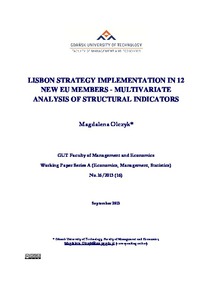Lisbon Strategy implementation in 12 new EU members – multivariate analysis of structural indicators

Gdansk University of Technology. Faculty of Management and Economics
Gdansk University of Technology - Gdansk
2013
22 p.
economic indicator ; European integration ; Lisbon strategy
GUT Working Papers
16
European Union
English
Bibliogr.
"The aim of this article is to identify diversity between the EU-15 and the New Members in their implementation of the Lisbon Strategy in the period 2000-2010. By analyzing a set of structural indicators, we aim to fill a gap in the literature: a lack of publications providing complex evaluation of the implementation of the Lisbon Strategy using measurable indicators. The results of our analyses confirm the hypothesis of a large gap between the EU-15 countries and the 12 New Members in key areas of the Lisbon Strategy. According to rankings given by our taxonomic analyses, a high level of the indicators selected is confirmed only for the EU-15 countries and only three New Members belong to a group presenting the average level of these indicators. This study demonstrates a need for a significant intensification of the EU cohesion policy, which is one of the main tools for achieving the Lisbon Strategy goals."
Digital
The ETUI is co-funded by the European Union. Views and opinions expressed are however those of the author(s) only and do not necessarily reflect those of the European Union or the ETUI.